Computational Simulation and Parametric Analysis of the Effectiveness of Ternary Nano-composites in Improving Magneto-Micropolar Liquid Heat Transport Performance
Abstract
:1. Introduction
2. Formulating the Governing Model
3. Numerical Approximation and Validation
4. Results and Discussion
5. Conclusions
- 1-
- Regardless of the influencing factors, the tri-hybrid nano-fluid, represented by GO-TiO2-Ag-ethylene glycol, produced the maximum value of the rate of energy transfer, velocity, angular velocity, skin friction, and temperature.
- 2-
- Elevating the value of the mixed convection factor improves heat transport, velocity, and angular velocity.
- 3-
- The volume fraction factor of tri-hybrid nano-particles has the potential to enhance all of the physical groups investigated in this study.
- 4-
- The velocity of the tri-hybrid nano-fluids and their ability to transfer energy are significantly suppressed when the magnetic field strength is increased.
- 5-
- Greater values of the micropolar factor have the ability to improve skin friction and temperature while inhibiting velocity, angular velocity, and energy transfer.
Author Contributions
Funding
Data Availability Statement
Conflicts of Interest
References
- Eringen, A.C. Simple microfluids. Int. J. Eng. Sci. 1964, 2, 205–217. [Google Scholar] [CrossRef]
- Eringen, A.C. Theory of thermomicrofluids. J. Math. Anal. Appl. 1972, 38, 480–496. [Google Scholar] [CrossRef]
- Abbas, N.; Saleem, S.; Nadeem, S.; Alderremy, A.; Khan, A. On stagnation point flow of a micro polar nanofluid past a circular cylinder with velocity and thermal slip. Res. Phys. 2018, 9, 1224–1232. [Google Scholar] [CrossRef]
- Swalmeh, M.Z.; Alkasasbeh, H.T.; Hussanan, A.; Mamat, M. Heat transfer flow of Cu-water and Al2O3-water micropolar nanofluids about a solid sphere in the presence of natural convection using Keller-box method. Res. Phys. 2018, 9, 717–724. [Google Scholar] [CrossRef]
- Alkasasbeh, H.T.; Swalmeh, M.Z.; Hussanan, A.; Mamat, M. Effects of mixed convection on methanol and kerosene oil based micropolar nanofluid containing oxide nanoparticles. CFD Lett. 2019, 11, 55–68. [Google Scholar]
- EL-Zahar, E.R.; Mansour, M.A.; Rashad, A.; EL-Mky, H.A.; EL-Hakiem, A.M. Micropolar nanoliquid flow via mixed convective over an orthogonal cylinder. Heat Transf. 2021, 50, 6425–6443. [Google Scholar] [CrossRef]
- Alwawi, F.; Sulaiman, I.M.; Swalmeh, M.Z.; Yaseen, N. Energy transport boosters of magneto micropolar fluid flowing past a cylinder: A case of laminar combined convection. Proc. Inst. Mech. Eng. C J. Mech. Eng. Sci. 2022, 236, 10902–10913. [Google Scholar] [CrossRef]
- Yaseen, N.; Shatat, F.; Alwawi, F.A.; Swalmeh, M.Z.; Kausar, M.S.; Sulaiman, I.M. Using Micropolar Nanofluid under a Magnetic Field to Enhance Natural Convective Heat Transfer around a Spherical Body. J. Adv. Res. Fluid Mech. Therm. Sci. 2022, 96, 179–193. [Google Scholar] [CrossRef]
- Choi, S.U.; Eastman, J.A. Enhancing Thermal Conductivity of Fluids with Nanoparticles; Argonne National Lab. (ANL): Argonne, IL, USA, 1995. [Google Scholar]
- Eastman, J.A.; Choi, S.; Li, S.; Yu, W.; Thompson, L. Anomalously increased effective thermal conductivities of ethylene glycol-based nanofluids containing copper nanoparticles. Appl. Phys. Lett. 2001, 78, 718–720. [Google Scholar] [CrossRef]
- Kuznetsov, A.; Nield, D. Natural convective boundary-layer flow of a nanofluid past a vertical plate. Int. J. Therm. Sci. 2010, 49, 243–247. [Google Scholar] [CrossRef]
- Dinarvand, S.; Abbassi, A.; Hosseini, R.; Pop, I. Homotopy analysis method for mixed convective boundary layer flow of a nanofluid over a vertical circular cylinder. Therm. Sci. 2015, 19, 549–561. [Google Scholar] [CrossRef]
- Rashad, A.; Nabwey, H.A. Gyrotactic mixed bioconvection flow of a nanofluid past a circular cylinder with convective boundary condition. J. Taiwan Inst. Chem. Eng. 2019, 99, 9–17. [Google Scholar] [CrossRef]
- Alwawi, F.A.; Hamarsheh, A.S.; Alkasasbeh, H.T.; Idris, R. Mixed Convection Flow of Magnetized Casson Nanofluid over a Cylindrical Surface. Coatings 2022, 12, 296. [Google Scholar] [CrossRef]
- Alsulami, M.; Naveen Kumar, R.; Punith Gowda, R.; Prasannakumara, B. Analysis of heat transfer using Local thermal non-equilibrium conditions for a non-Newtonian fluid flow containing Ti6Al4V and AA7075 nanoparticles in a porous media. ZAMM-J. Appl. Math. Mech./Z. Für Angew. Math. Und Mech. 2022, e202100360. [Google Scholar] [CrossRef]
- Zaher, A.; Ali, K.K.; Mekheimer, K.S. Electroosmosis forces EOF driven boundary layer flow for a non-Newtonian fluid with planktonic microorganism: Darcy Forchheimer model. Int. J. Numer. Methods Heat Fluid Flow 2021, 31, 2534–2559. [Google Scholar] [CrossRef]
- Abbas, W.; Mekheimer, K.S.; Ghazy, M.; Moawad, A. Thermal radiation effects on oscillatory squeeze flow with a particle-fluid suspension. Heat Transf. 2021, 50, 2129–2149. [Google Scholar] [CrossRef]
- Mekheimer, K.S.; Ramadan, S.F. New insight into gyrotactic microorganisms for bio-thermal convection of Prandtl nanofluid over a stretching/shrinking permeable sheet. SN Appl. Sci. 2020, 2, 1–11. [Google Scholar] [CrossRef]
- Turcu, R.; Darabont, A.; Nan, A.; Aldea, N.; Macovei, D.; Bica, D.; Vekas, L.; Pana, O.; Soran, M.; Koos, A. New polypyrrole-multiwall carbon nanotubes hybrid materials. J. Optoelectron. Adv. Mater. 2006, 8, 643–647. [Google Scholar]
- Suresh, S.; Venkitaraj, K.; Selvakumar, P.; Chandrasekar, M. Synthesis of Al2O3–Cu/water hybrid nanofluids using two step method and its thermo physical properties. Colloids Surf. A Physicochem. Eng. Asp. 2011, 388, 41–48. [Google Scholar] [CrossRef]
- Baghbanzadeh, M.; Rashidi, A.; Rashtchian, D.; Lotfi, R.; Amrollahi, A. Synthesis of spherical silica/multiwall carbon nanotubes hybrid nanostructures and investigation of thermal conductivity of related nanofluids. Thermochim. Acta 2012, 549, 87–94. [Google Scholar] [CrossRef]
- Leong, K.; Ahmad, K.K.; Ong, H.C.; Ghazali, M.; Baharum, A. Synthesis and thermal conductivity characteristic of hybrid nanofluids—A review. Renew. Sustain. Energy Rev. 2017, 75, 868–878. [Google Scholar] [CrossRef]
- Muneeshwaran, M.; Srinivasan, G.; Muthukumar, P.; Wang, C.-C. Role of hybrid-nanofluid in heat transfer enhancement—A review. Int. Commun. Heat Mass Transf. 2021, 125, 105341. [Google Scholar] [CrossRef]
- Nadeem, S.; Abbas, N.; Khan, A. Characteristics of three dimensional stagnation point flow of Hybrid nanofluid past a circular cylinder. Res. Phys. 2018, 8, 829–835. [Google Scholar] [CrossRef]
- Dinarvand, S.; Nademi Rostami, M. Mixed convection of a Cu-Ag/water hybrid nanofluid along a vertical porous cylinder via modified Tiwari-Das model. J. Theor. Appl. Mech. 2019, 49, 149–169. [Google Scholar] [CrossRef]
- Rashad, A.M.; Khan, W.A.; EL-Kabeir, S.M.; EL-Hakiem, A.M. Mixed convective flow of micropolar nanofluid across a horizontal cylinder in saturated porous medium. Appl. Sci. 2019, 9, 5241. [Google Scholar] [CrossRef]
- Alharbi, S.O.; Nawaz, M.; Nazir, U. Thermal analysis for hybrid nanofluid past a cylinder exposed to magnetic field. AIP Adv. 2019, 9, 115022. [Google Scholar] [CrossRef]
- Shah, Z.; Saeed, A.; Khan, I.; Selim, M.M.; Ikramullah; Kumam, P. Numerical modeling on hybrid nanofluid (Fe3O4+MWCNT/H2O) migration considering MHD effect over a porous cylinder. PLoS ONE 2021, 16, e0251744. [Google Scholar] [CrossRef]
- John Christopher, A.; Magesh, N.; Punith Gowda, R.J.; Naveen Kumar, R.; Varun Kumar, R.S. Hybrid nanofluid flow over a stretched cylinder with the impact of homogeneous–heterogeneous reactions and Cattaneo–Christov heat flux: Series solution and numerical simulation. Heat Transf. 2021, 50, 3800–3821. [Google Scholar] [CrossRef]
- Alwawi, F.; Swalmeh, M.; Sulaiman, I.; Yaseen, N.; Alkasasbeh, H.; Al Soub, T. Numerical investigation of heat transfer characteristics for blood/water-based hybrid nanofluids in free convection about a circular cylinder. J. Mech. Eng. Sci. 2022, 16, 8931–8942. [Google Scholar] [CrossRef]
- Alwawi, F.A.; Al Faqih, F.M.; Swalmeh, M.Z.; Ibrahim, M.A.H. Combined Convective Energy Transmission Performance of Williamson Hybrid Nanofluid over a Cylindrical Shape with Magnetic and Radiation Impressions. Mathematics 2022, 10, 3191. [Google Scholar] [CrossRef]
- Alzu’bi, O.A.S.; Alwawi, F.A.; Swalmeh, M.Z.; Sulaiman, I.M.; Hamarsheh, A.S.; Ibrahim, M.A.H. Energy Transfer through a Magnetized Williamson Hybrid Nanofluid Flowing around a Spherical Surface: Numerical Simulation. Mathematics 2022, 10, 3823. [Google Scholar] [CrossRef]
- Alwawi, F.A.; Swalmeh, M.Z.; Qazaq, A.S.; Idris, R. Heat Transmission Reinforcers Induced by MHD Hybrid Nanoparticles for Water/Water-EG Flowing over a Cylinder. Coatings 2021, 11, 623. [Google Scholar] [CrossRef]
- Xuan, Z.; Zhai, Y.; Ma, M.; Li, Y.; Wang, H. Thermo-economic performance and sensitivity analysis of ternary hybrid nanofluids. J. Mol. Liq. 2021, 323, 114889. [Google Scholar] [CrossRef]
- Cakmak, N.K.; Said, Z.; Sundar, L.S.; Ali, Z.M.; Tiwari, A.K. Preparation, characterization, stability, and thermal conductivity of rGO-Fe3O4-TiO2 hybrid nanofluid: An experimental study. Powder Technol. 2020, 372, 235–245. [Google Scholar] [CrossRef]
- Souby, M.M.; Bargal, M.H.; Wang, Y. Thermohydraulic performance improvement and entropy generation characteristics of a microchannel heat sink cooled with new hybrid nanofluids containing ternary/binary hybrid nanocomposites. Energy Sci. Eng. 2021, 9, 2493–2513. [Google Scholar] [CrossRef]
- Mahmood, Z.; Iqbal, Z.; Alyami, M.A.; Alqahtani, B.; Yassen, M.F.; Khan, U. Influence of suction and heat source on MHD stagnation point flow of ternary hybrid nanofluid over convectively heated stretching/shrinking cylinder. Adv. Mech. Eng. 2022, 14, 16878132221126278. [Google Scholar] [CrossRef]
- Alharbi, K.A.M.; Ahmed, A.E.-S.; Ould Sidi, M.; Ahammad, N.A.; Mohamed, A.; El-Shorbagy, M.A.; Bilal, M.; Marzouki, R. Computational valuation of darcy ternary-hybrid nanofluid flow across an extending cylinder with induction effects. Micromachines 2022, 13, 588. [Google Scholar] [CrossRef] [PubMed]
- Nazir, U.; Saleem, S.; Al-Zubaidi, A.; Shahzadi, I.; Feroz, N. Thermal and mass species transportation in tri-hybridized Sisko martial with heat source over vertical heated cylinder. Int. Commun. Heat Mass Transf. 2022, 134, 106003. [Google Scholar] [CrossRef]
- Khan, U.; Kumar, R.N.; Zaib, A.; Prasannakumara, B.; Ishak, A.; Galal, A.M.; Gowda, R.P. Time-dependent flow of water-based ternary hybrid nanoparticles over a radially contracting/expanding and rotating permeable stretching sphere. Therm. Sci. Eng. Prog. 2022, 36, 101521. [Google Scholar] [CrossRef]
- Sarada, K.; Gamaoun, F.; Abdulrahman, A.; Paramesh, S.; Kumar, R.; Prasanna, G.; Gowda, R.P. Impact of exponential form of internal heat generation on water-based ternary hybrid nanofluid flow by capitalizing non-Fourier heat flux model. Case Stud. Therm. Eng. 2022, 38, 102332. [Google Scholar]
- Kumar, R.N.; Gamaoun, F.; Abdulrahman, A.; Chohan, J.S.; Gowda, R.P. Heat transfer analysis in three-dimensional unsteady magnetic fluid flow of water-based ternary hybrid nanofluid conveying three various shaped nanoparticles: A comparative study. Int. J. Mod. Phys. B 2022, 36, 2250170. [Google Scholar] [CrossRef]
- Sarangi, M.; Thatoi, D.; Nayak, M.; Prakash, J.; Ramesh, K.; Azam, M. Rotational flow and thermal behavior of ternary hybrid nanomaterials at small and high Prandtl numbers. Int. Commun. Heat Mass Transf. 2022, 138, 106337. [Google Scholar] [CrossRef]
- Puneeth, V.; Manjunatha, S.; Ganesh Kumar, K.; Gnaneswara Reddy, M. Perspective of multiple slips on 3D flow of Al2O3–TiO2–CuO/H2O ternary nanofluid past an extending surface due to non-linear thermal radiation. Waves Random Complex Media 2022, 1–19. [Google Scholar] [CrossRef]
- Sajid, T.; Ayub, A.; Shah, S.Z.H.; Jamshed, W.; Eid, M.R.; El Din, E.S.M.T.; Irfan, R.; Hussain, S.M. Trace of Chemical Reactions Accompanied with Arrhenius Energy on Ternary Hybridity Nanofluid Past a Wedge. Symmetry 2022, 14, 1850. [Google Scholar] [CrossRef]
- Hafeez, M.B.; Krawczuk, M.; Nisar, K.S.; Jamshed, W.; Pasha, A.A. A finite element analysis of thermal energy inclination based on ternary hybrid nanoparticles influenced by induced magnetic field. Int. Commun. Heat Mass Transf. 2022, 135, 106074. [Google Scholar] [CrossRef]
- Rauf, A.; Shah, N.A.; Botmart, T. Hall current and morphological effects on MHD micropolar non-Newtonian tri-hybrid nanofluid flow between two parallel surfaces. Sci. Rep. 2022, 12, 16608. [Google Scholar] [CrossRef]
- Dhanai, R.; Rana, P.; Kumar, L. MHD mixed convection nanofluid flow and heat transfer over an inclined cylinder due to velocity and thermal slip effects: Buongiorno’s model. Powder Technol. 2016, 288, 140–150. [Google Scholar] [CrossRef]
- Alizadeh, R.; Karimi, N.; Arjmandzadeh, R.; Mehdizadeh, A. Mixed convection and thermodynamic irreversibilities in MHD nanofluid stagnation-point flows over a cylinder embedded in porous media. J. Therm. Anal. Calorim. 2019, 135, 489–506. [Google Scholar] [CrossRef]
- Patil, P.; Kulkarni, M. Analysis of MHD mixed convection in a Ag-TiO2 hybrid nanofluid flow past a slender cylinder. Chin. J. Phys. 2021, 73, 406–419. [Google Scholar] [CrossRef]
- Ullah, Z.; Ehsan, M.; Ahmad, H.; Ilyas, A. Combined effects of MHD and slip velocity on oscillatory mixed convective flow around a non-conducting circular cylinder embedded in a porous medium. Case Stud. Therm. Eng. 2022, 38, 102341. [Google Scholar] [CrossRef]
- Umavathi, J.; Prakasha, D.; Alanazi, Y.M.; Lashin, M.M.; Al-Mubaddel, F.S.; Kumar, R.; Gowda, R.P. Magnetohydrodynamic squeezing Casson nanofluid flow between parallel convectively heated disks. Int. J. Mod. Phys. B 2023, 37, 2350031. [Google Scholar] [CrossRef]
- Sharma, B.; Khanduri, U.; Mishra, N.K.; Mekheimer, K.S. Combined effect of thermophoresis and Brownian motion on MHD mixed convective flow over an inclined stretching surface with radiation and chemical reaction. Int. J. Mod. Phys. B 2022, 2350095. [Google Scholar] [CrossRef]
- Shahid, A.; Bhatti, M.; Ellahi, R.; Mekheimer, K.S. Numerical experiment to examine activation energy and bi-convection Carreau nanofluid flow on an upper paraboloid porous surface: Application in solar energy. Sustain. Energy Technol. Assess. 2022, 52, 102029. [Google Scholar] [CrossRef]
- Prasad, V.R.; Gaffar, S.A.; Bég, O.A. Heat and mass transfer of nanofluid from horizontal cylinder to micropolar fluid. J. Thermophys. Heat Transf. 2015, 29, 127–139. [Google Scholar] [CrossRef]
- Hou, E.; Wang, F.; Nazir, U.; Sohail, M.; Jabbar, N.; Thounthong, P. Dynamics of tri-hybrid nanoparticles in the rheology of pseudo-plastic liquid with dufour and soret effects. Micromachines 2022, 13, 201. [Google Scholar] [CrossRef]
- Nazir, U.; Sohail, M.; Kumam, P.; Sitthithakerngkiet, K.; Mousa, A.A.A.; Khan, M.J.; Galal, A.M. A dynamic assessment of various non-Newtonian models for ternary hybrid nanomaterial involving partially ionized mechanism. Sci. Rep. 2022, 12, 10306. [Google Scholar] [CrossRef]
- Swalmeh, M.; Alkasasbeh, H.; Hussanan, A.; Mamat, M. Numerical study of mixed convection heat transfer in methanol based micropolar nanofluid about a horizontal circular cylinder. J. Phys. Conf. Ser. 2019, 1366, 012003. [Google Scholar] [CrossRef]
- Nazar, R.; Amin, N.; Pop, I. Mixed convection boundary-layer flow from a horizontal circular cylinder with a constant surface heat flux. Heat Mass Transf. 2004, 40, 219–227. [Google Scholar] [CrossRef]
- Cebeci, T.; Bradshaw, P. Physical and Computational Aspects of Convective Heat Transfer; Springer Science & Business Media: New York, NY, USA, 2012. [Google Scholar]
- Swalmeh, M.Z.; Shatat, F.; Alwawi, F.A.; Ibrahim, M.A.H.; Sulaiman, I.M.; Yaseen, N.; Naser, M.F. Effectiveness of Radiation on Magneto-Combined Convective Boundary Layer Flow in Polar Nanofluid around a Spherical Shape. Fractal Fract. 2022, 6, 383. [Google Scholar] [CrossRef]
- Swalmeh, M.Z. Numerical solutions of hybrid nanofluids flow via free convection over a solid sphere. J. Adv. Res. Fluid Mech. Therm. Sci. 2021, 83, 34–45. [Google Scholar] [CrossRef]
- Alwawi, F.A.; Alkasasbeh, H.T.; Rashad, A.; Idris, R. Heat transfer analysis of ethylene glycol-based Casson nanofluid around a horizontal circular cylinder with MHD effect. Proc. Inst. Mech. Eng. C J. Mech. Eng. Sci. 2020, 234, 2569–2580. [Google Scholar] [CrossRef]
- Mahdy, A. Simultaneous impacts of MHD and variable wall temperature on transient mixed Casson nanofluid flow in the stagnation point of rotating sphere. Appl. Math. Mech. 2018, 39, 1327–1340. [Google Scholar] [CrossRef]
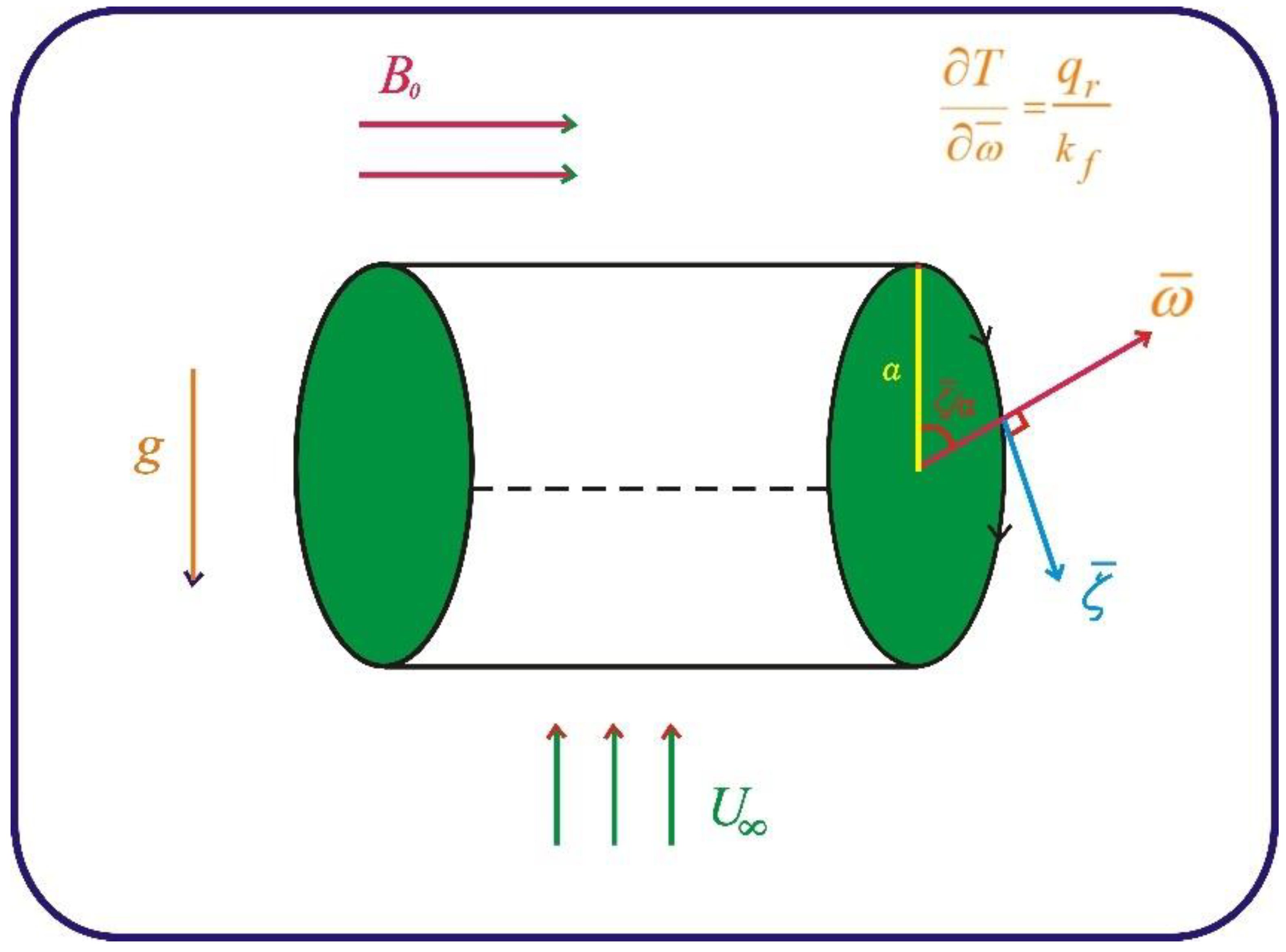
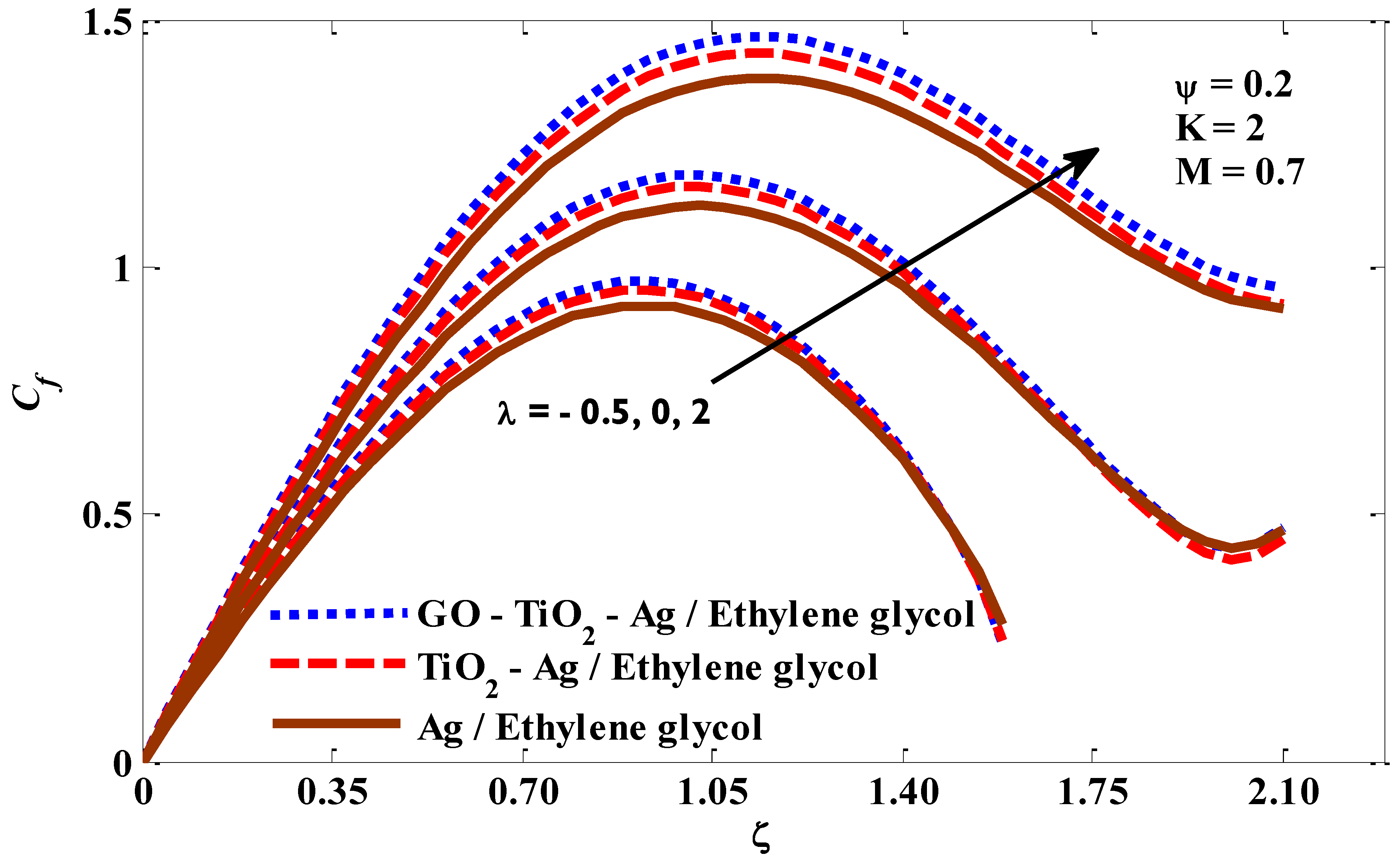
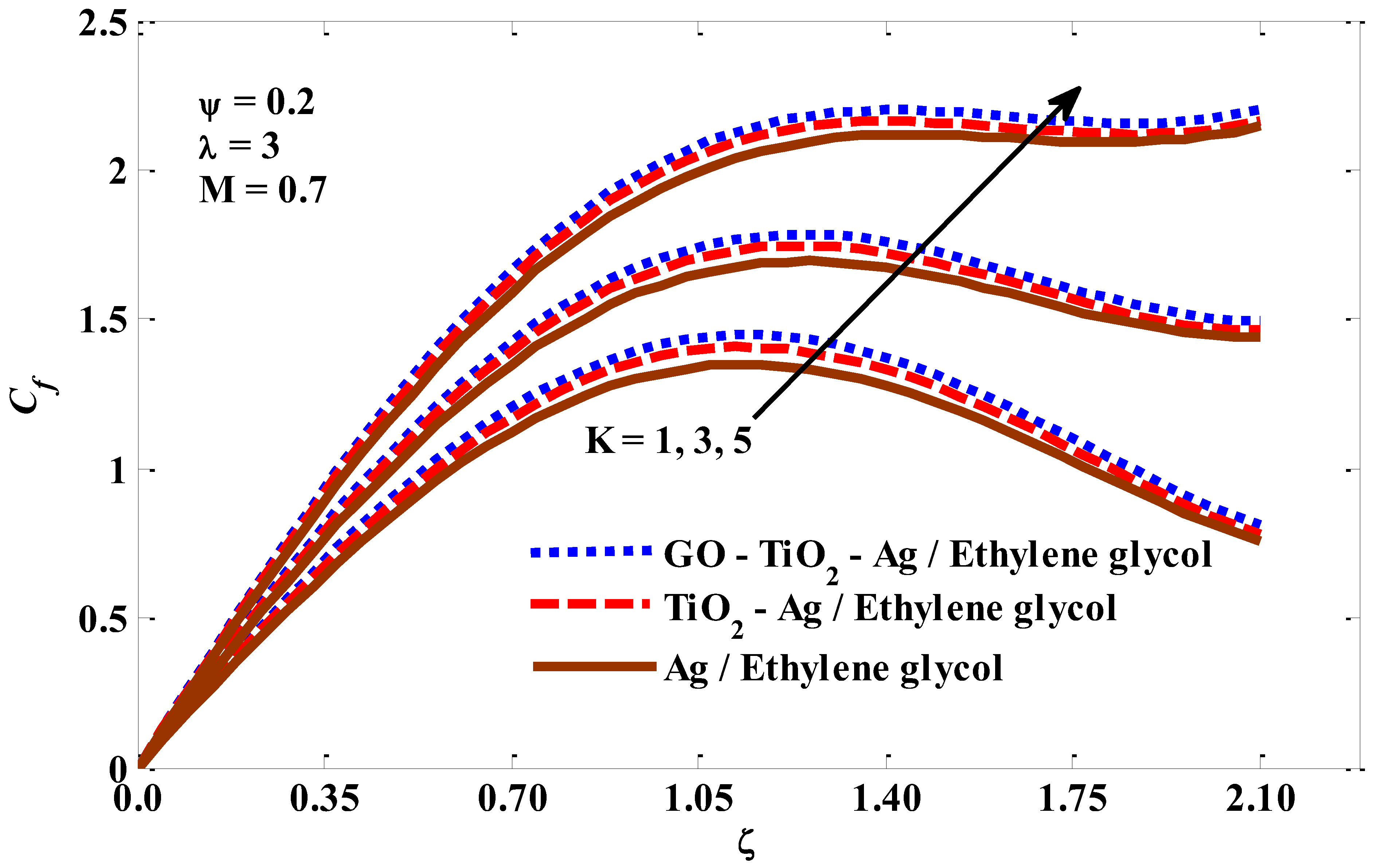


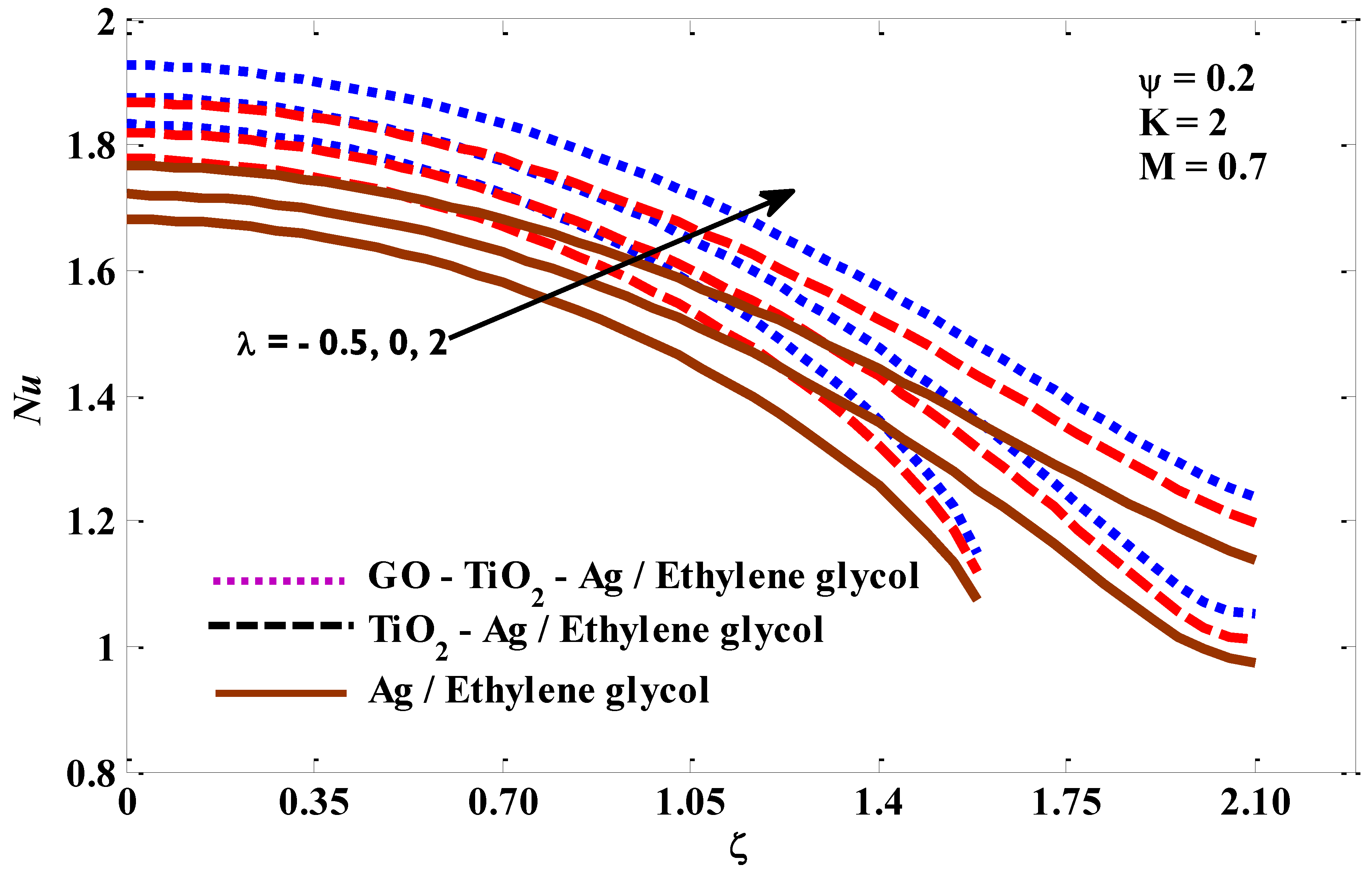
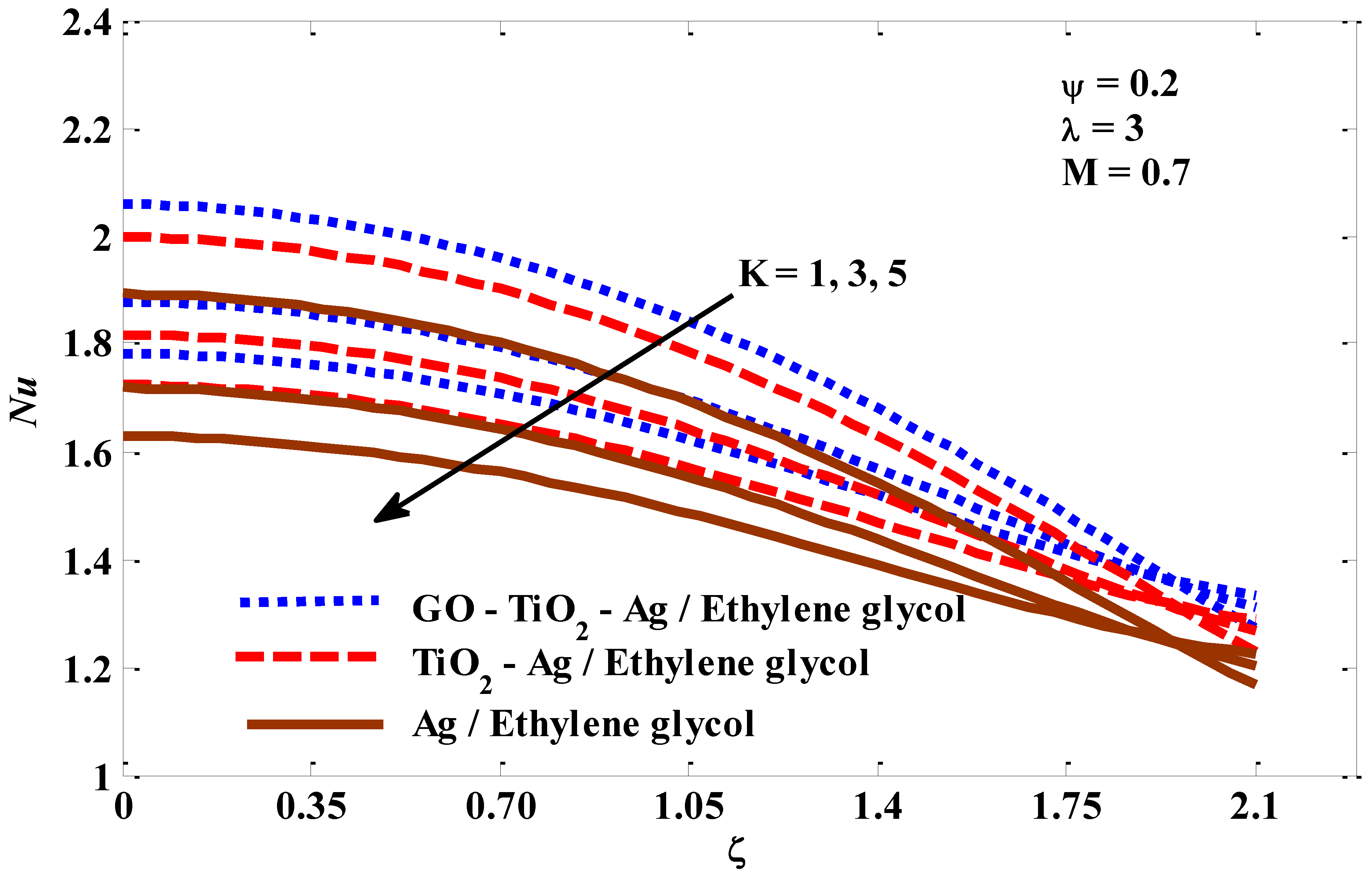
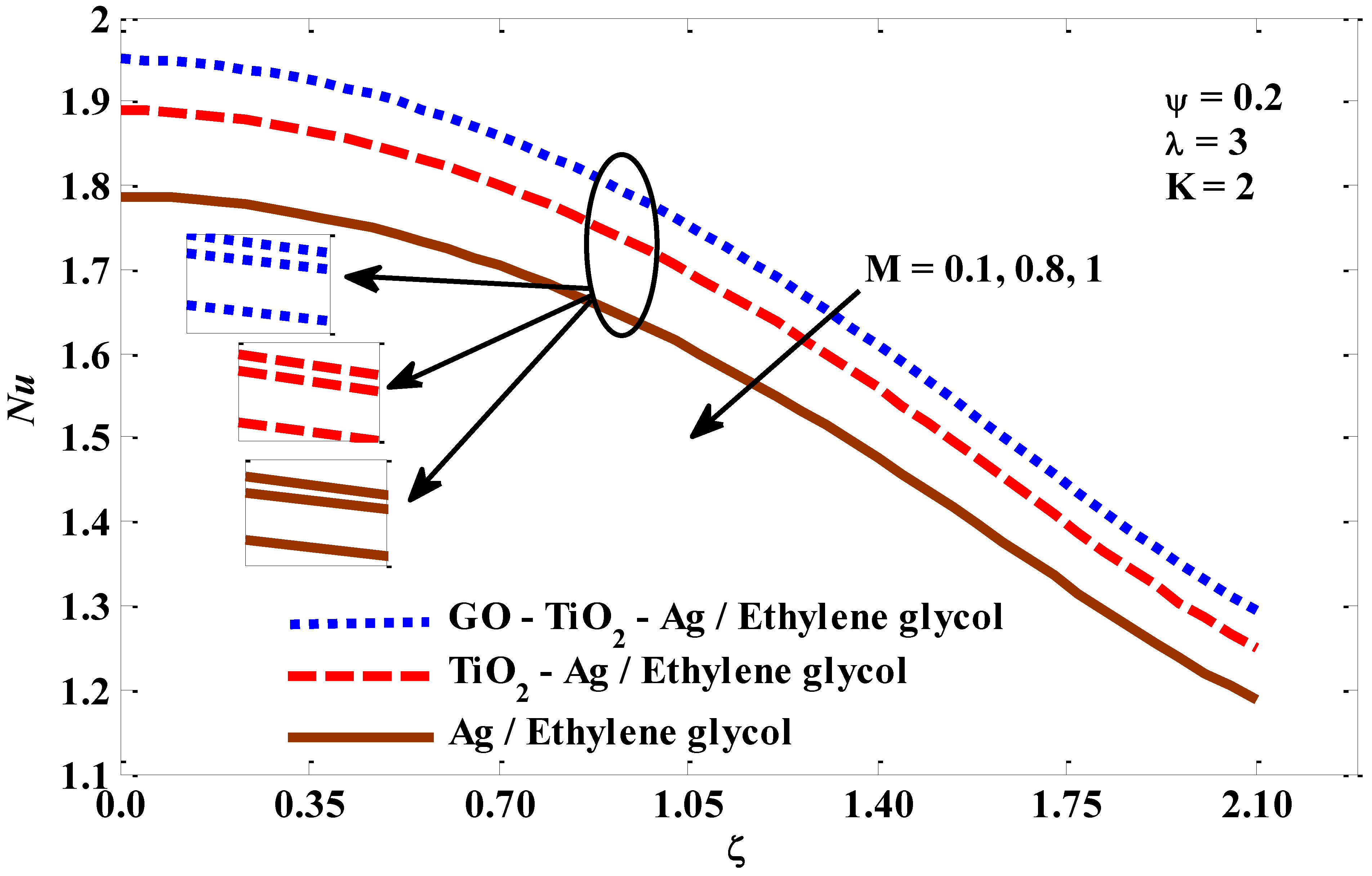
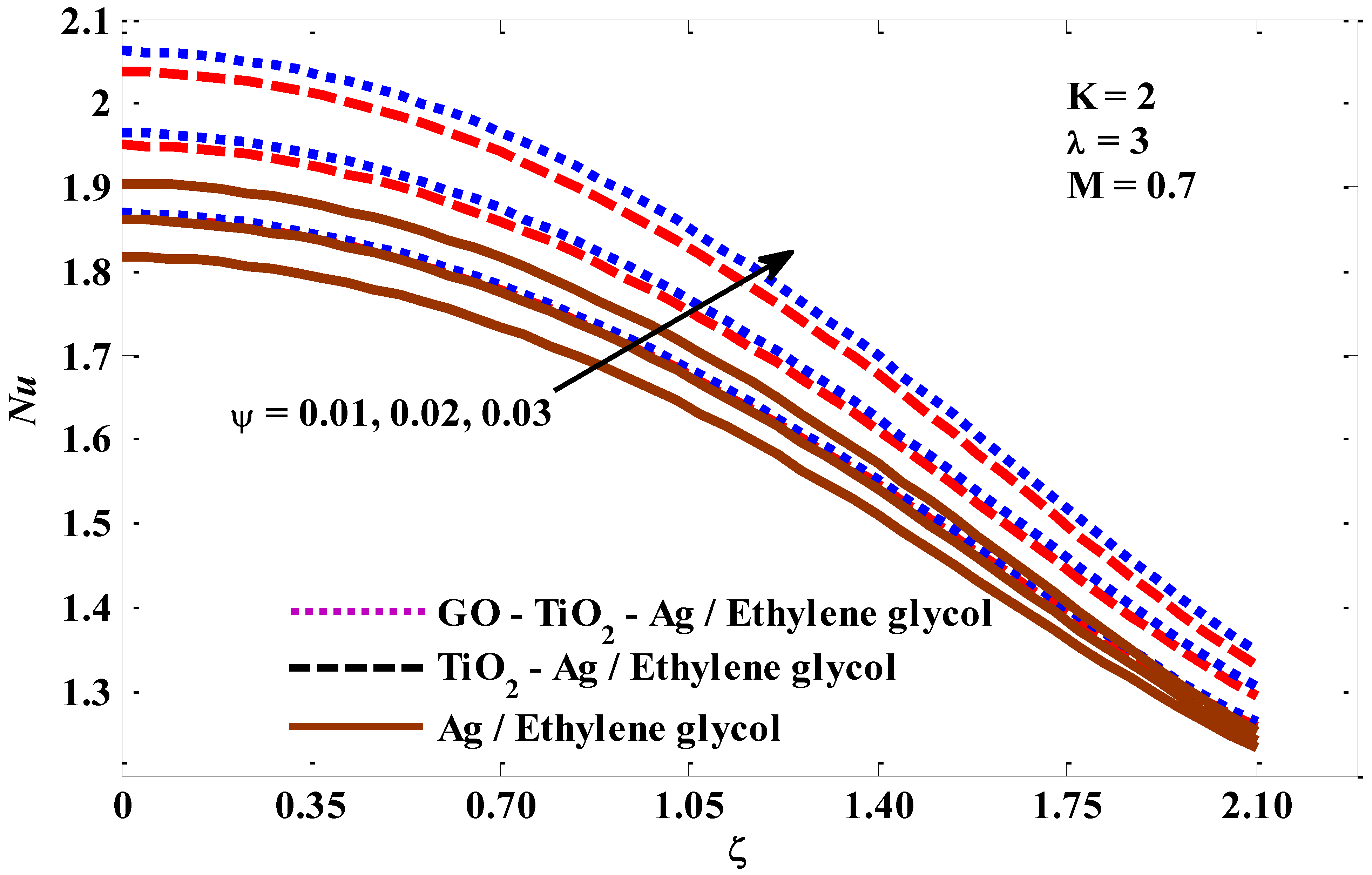

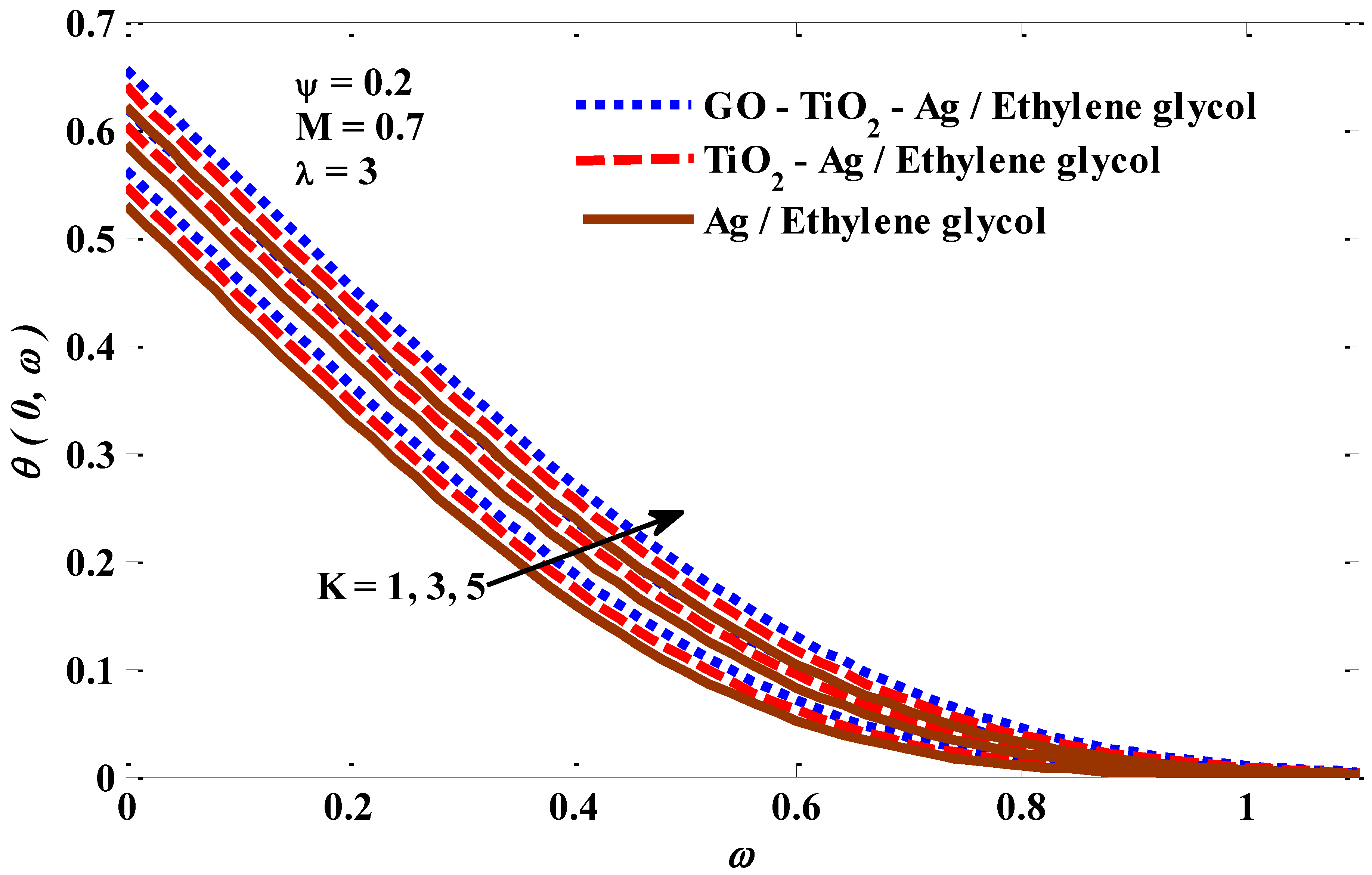
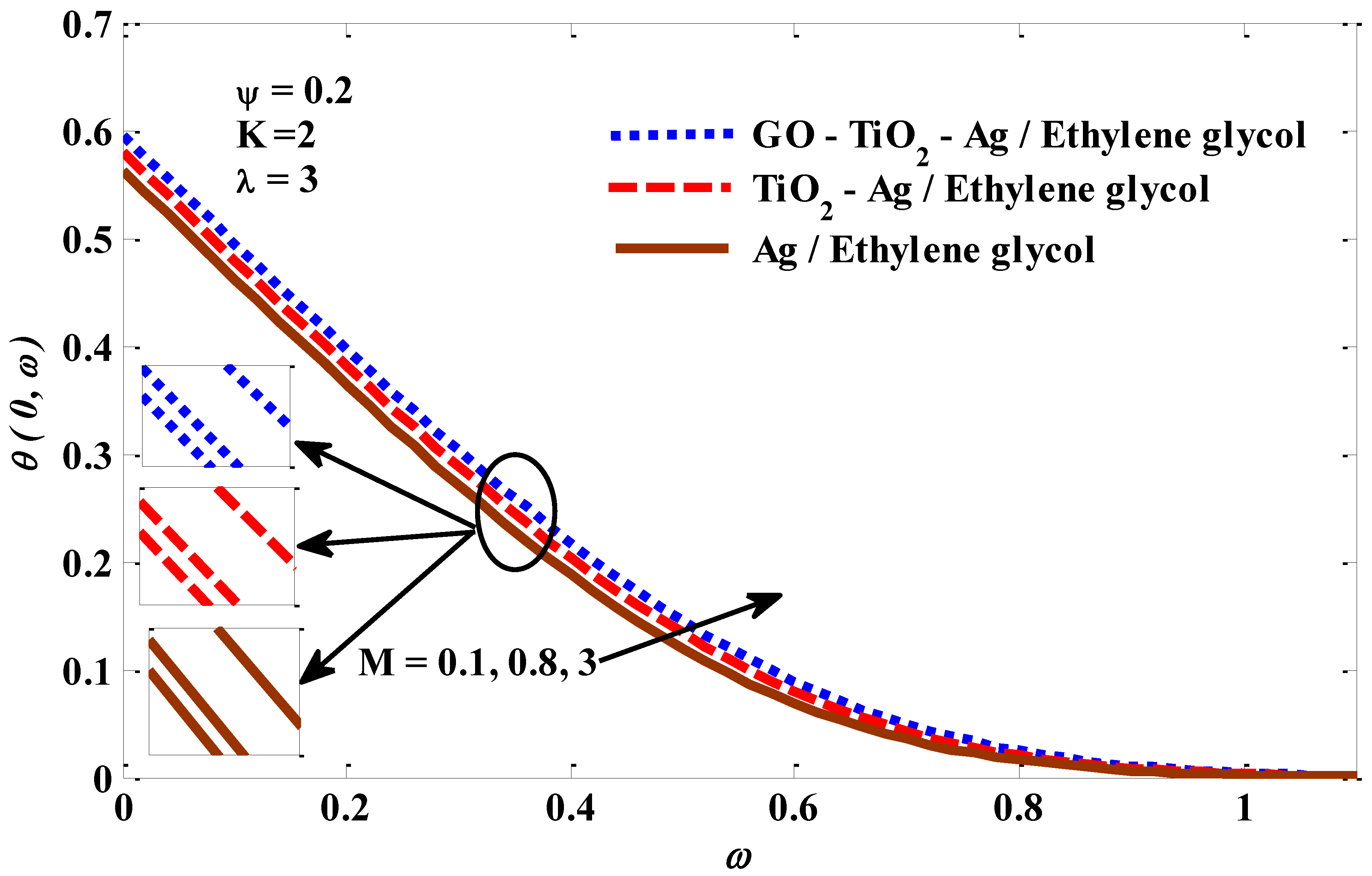
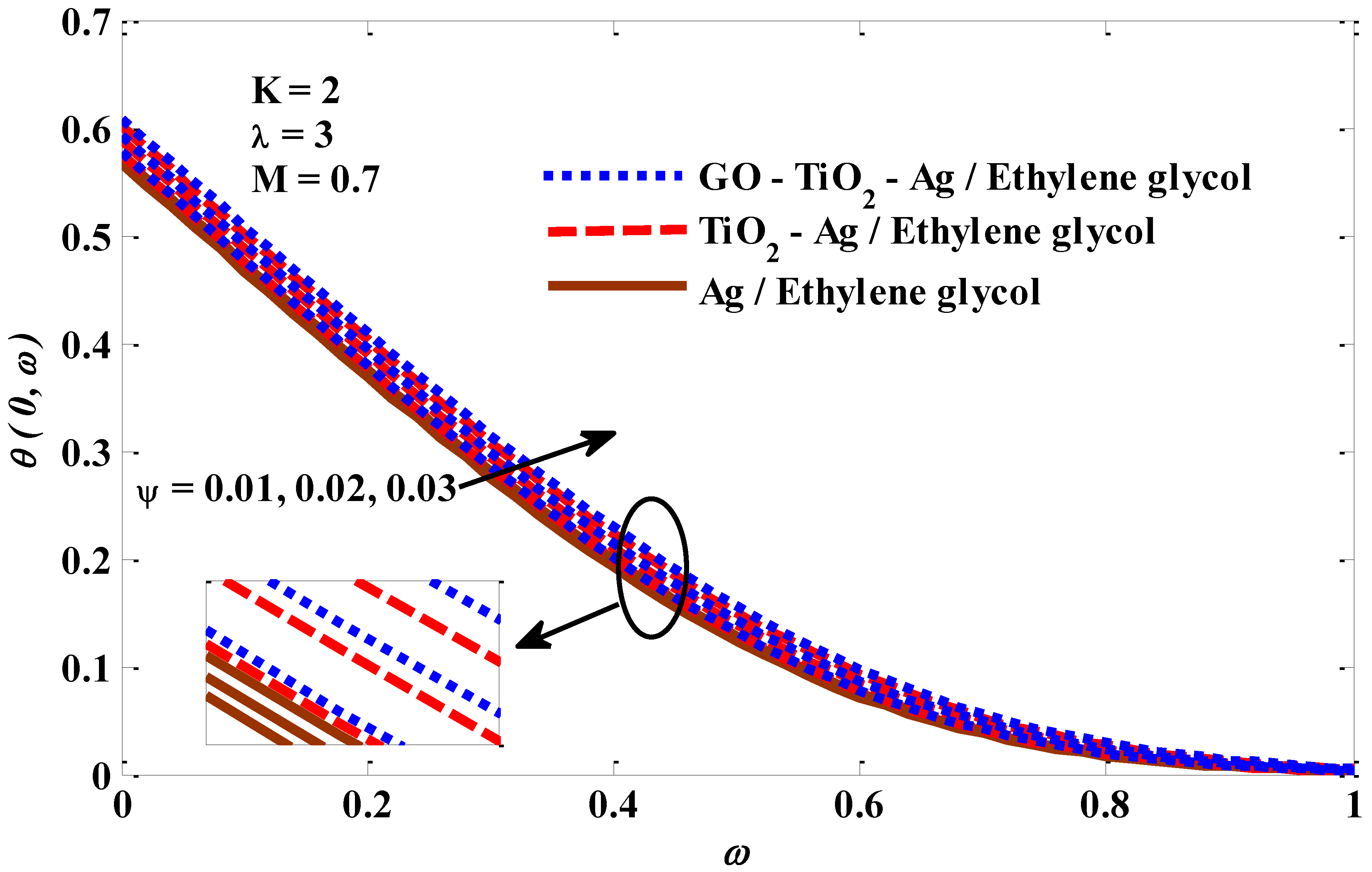
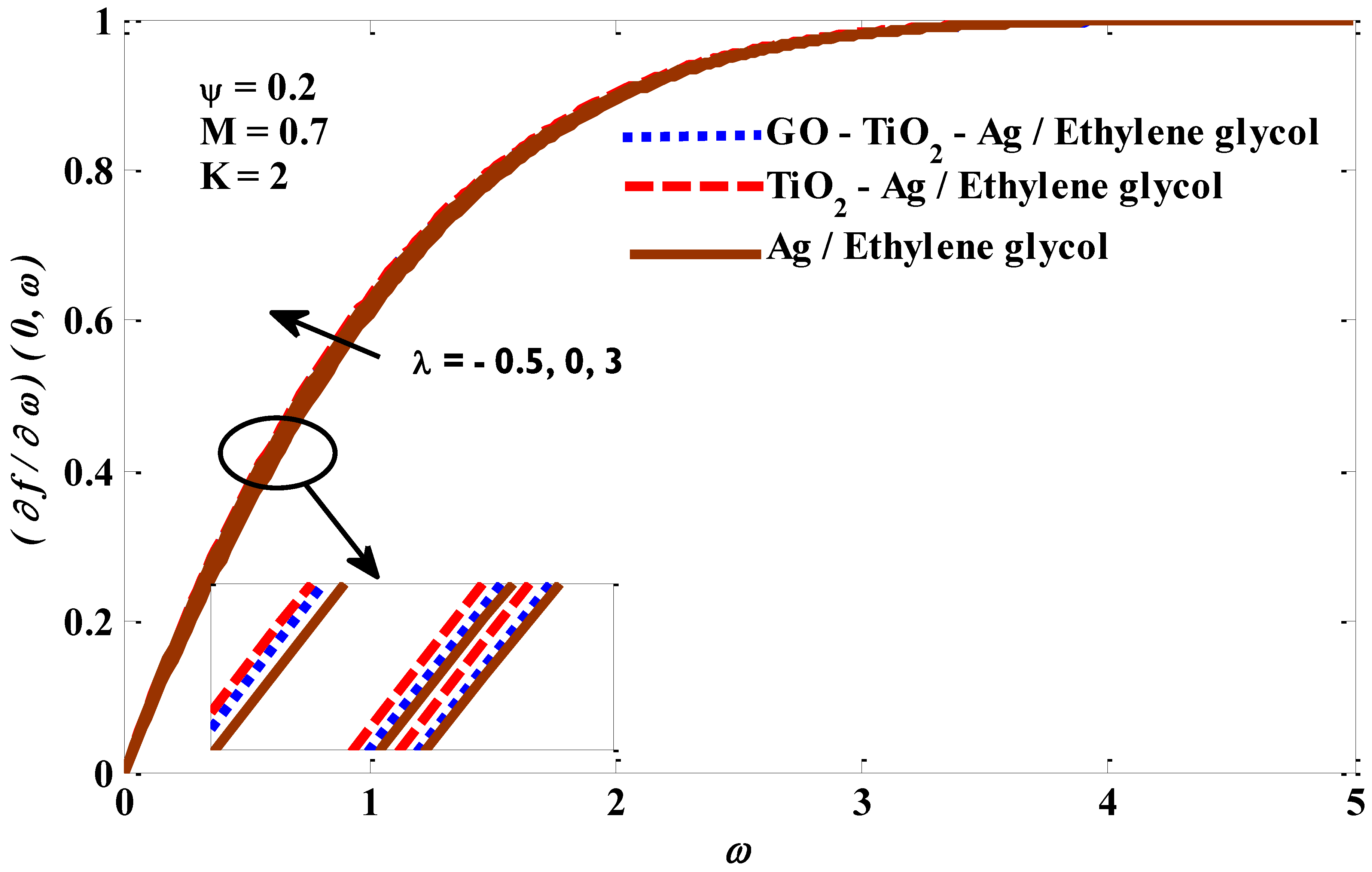
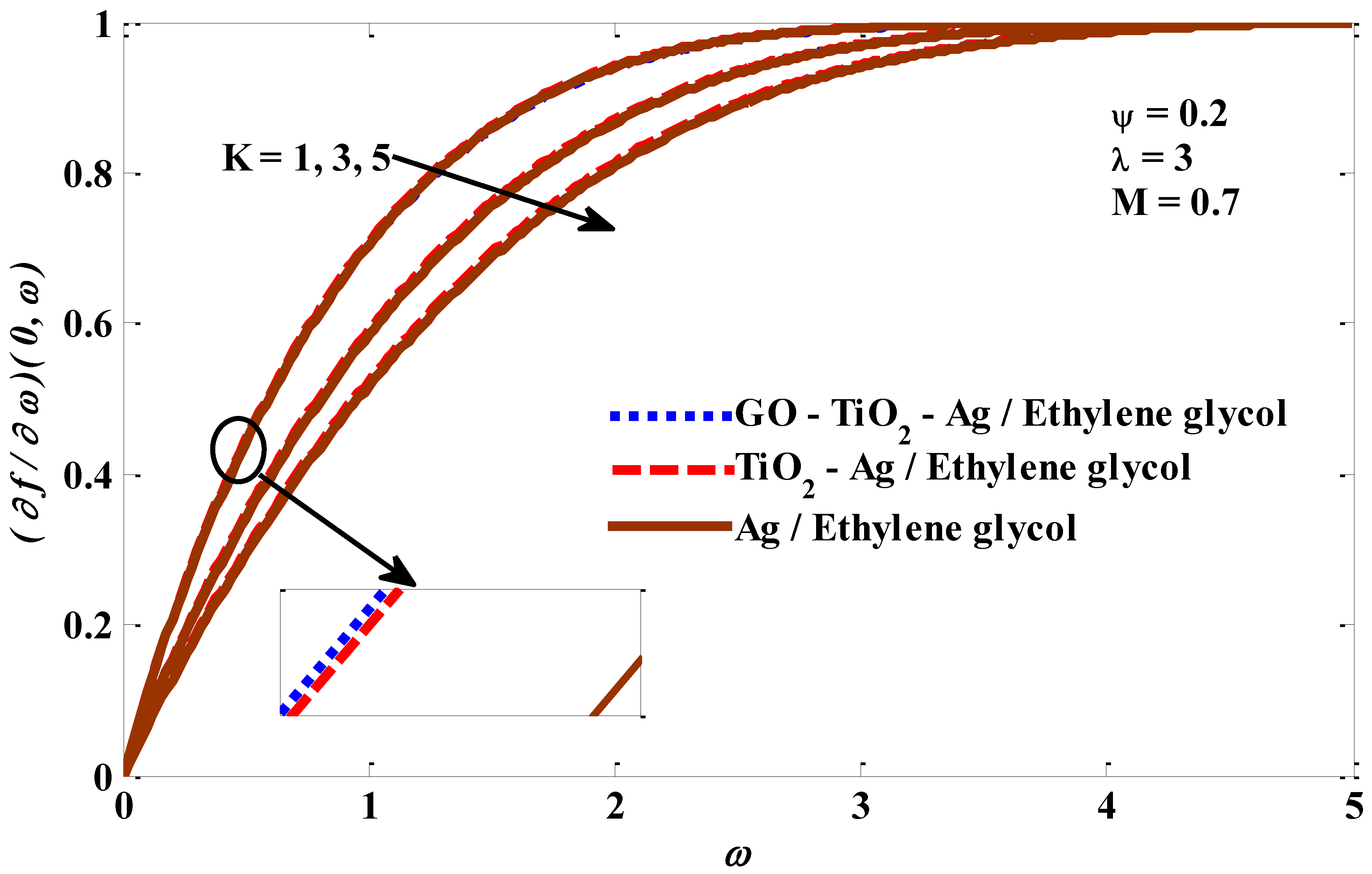
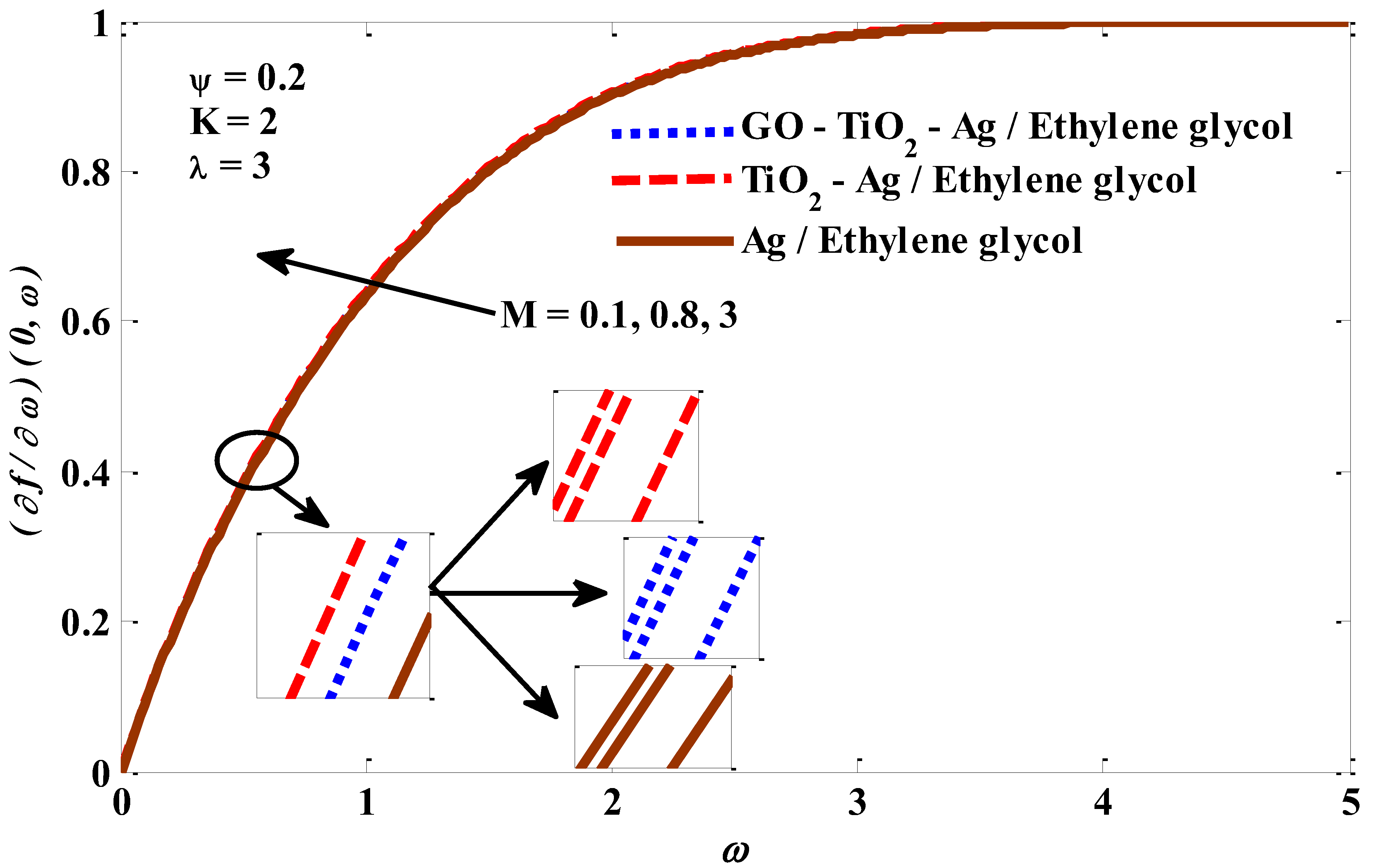
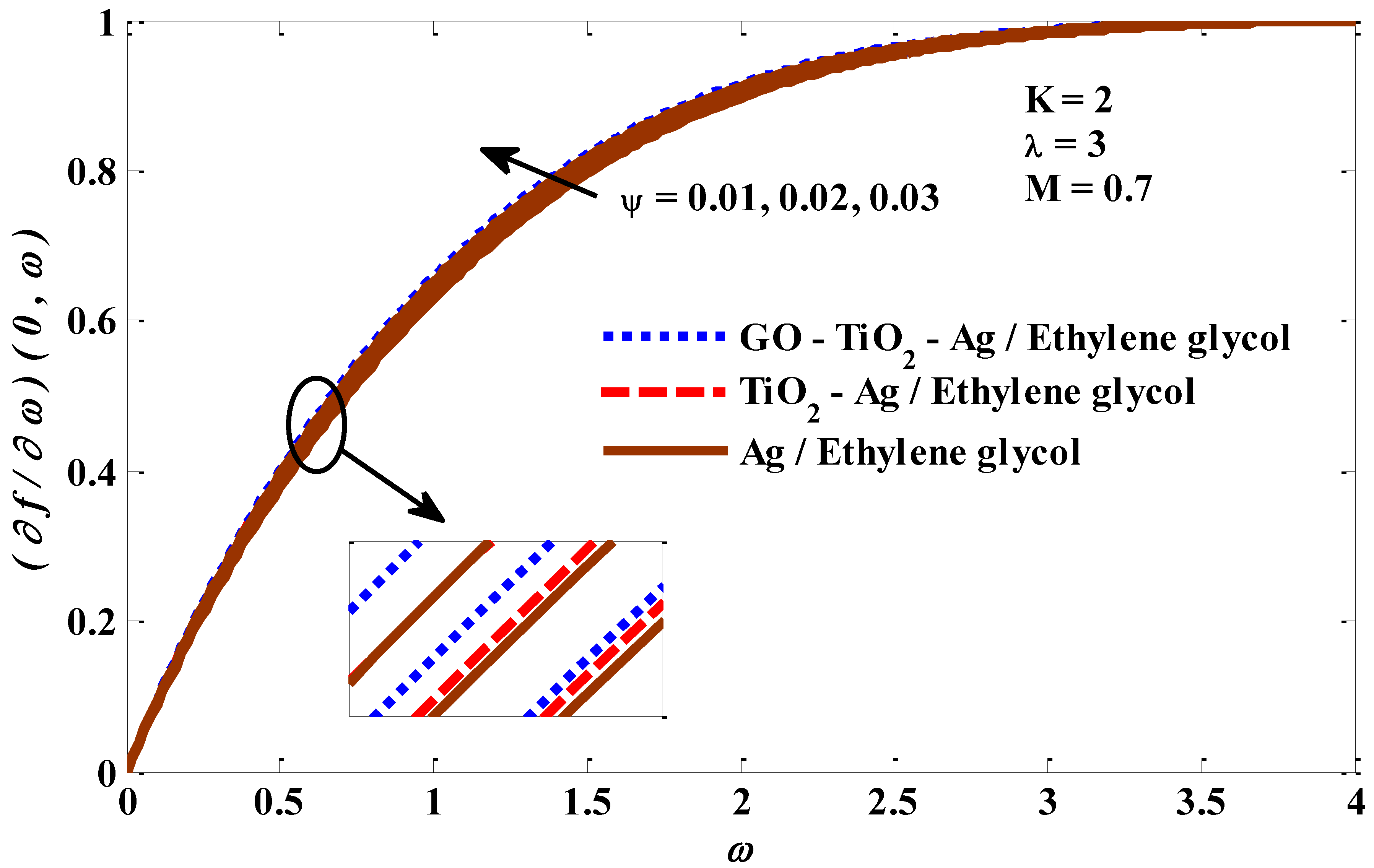
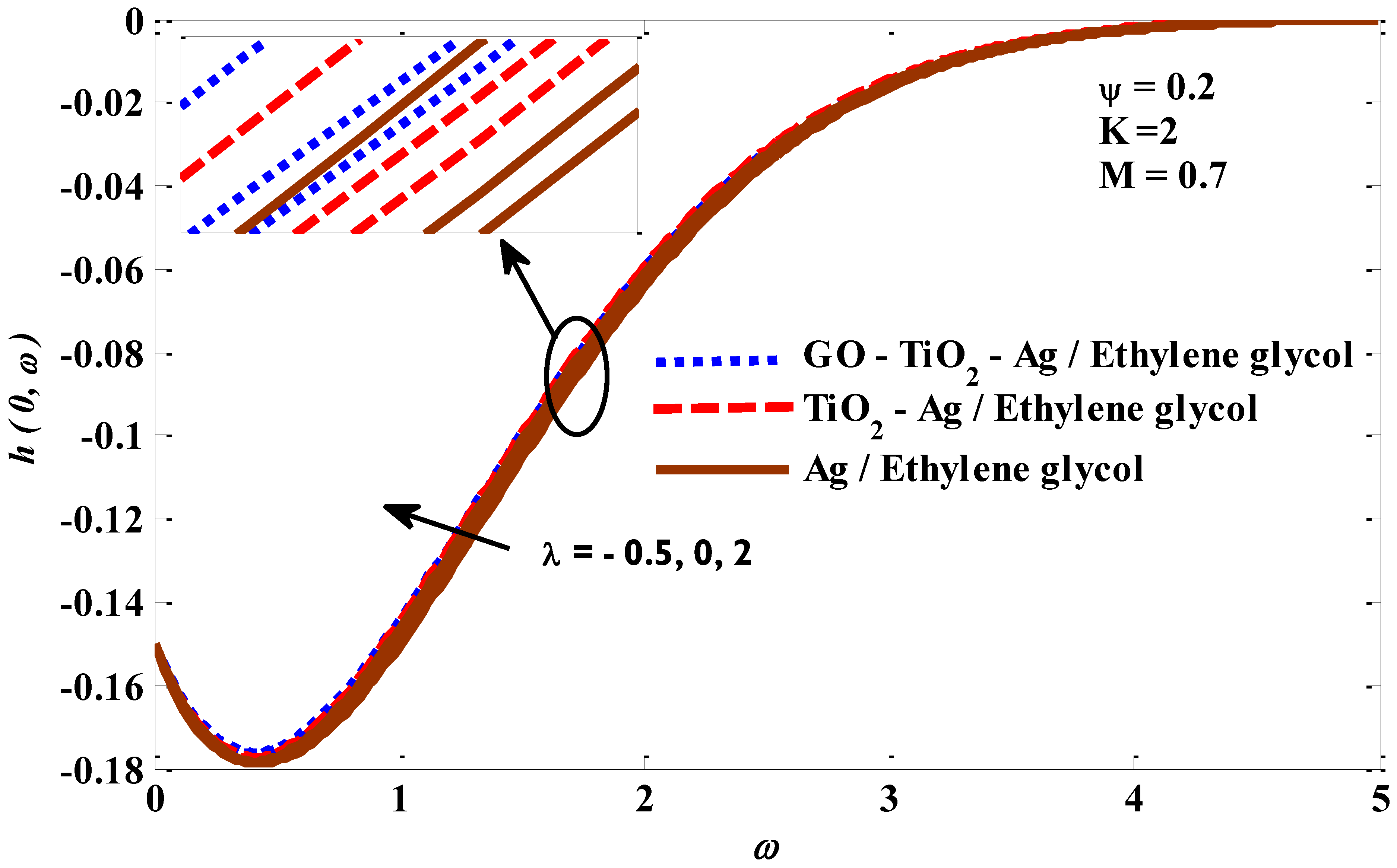
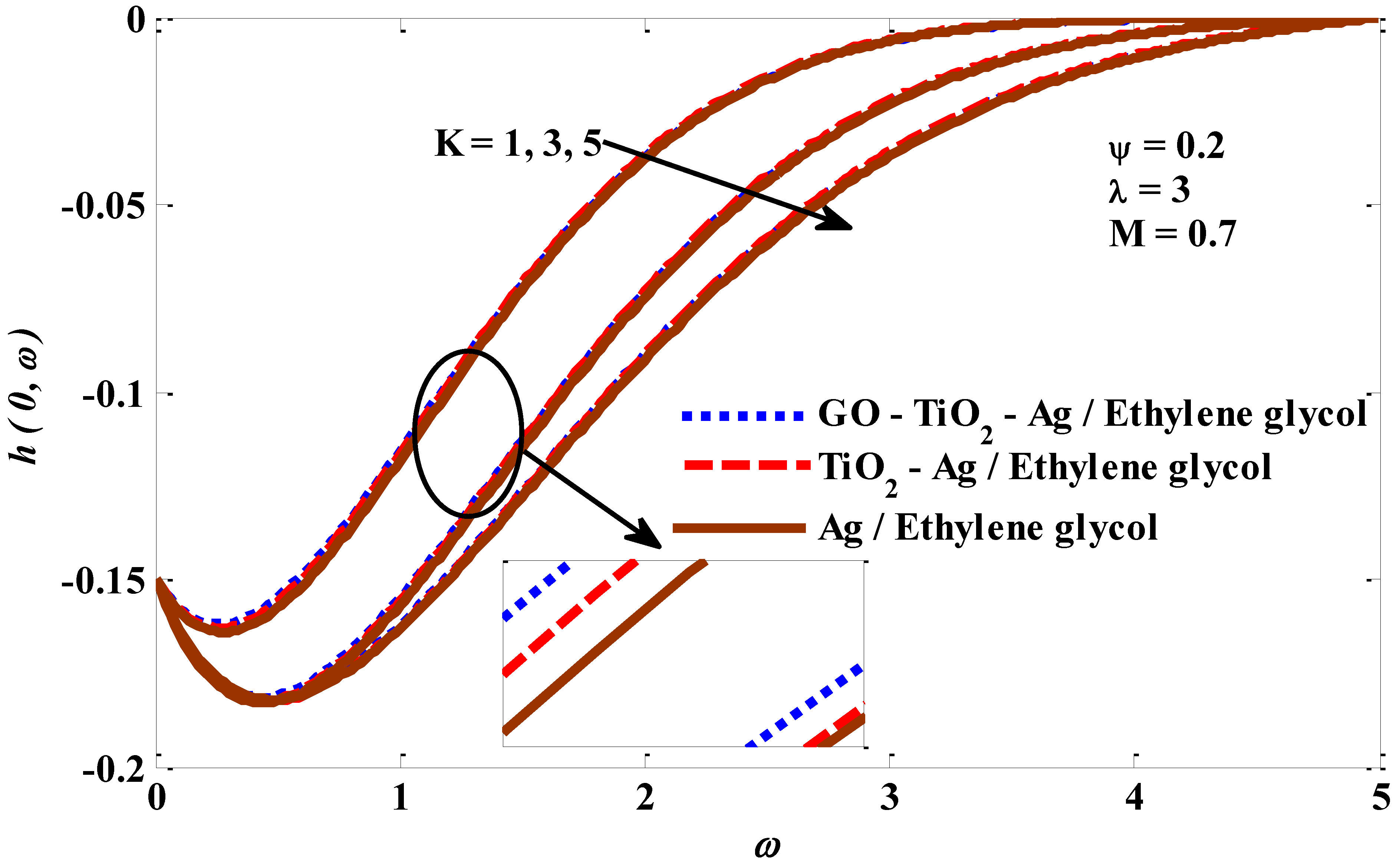
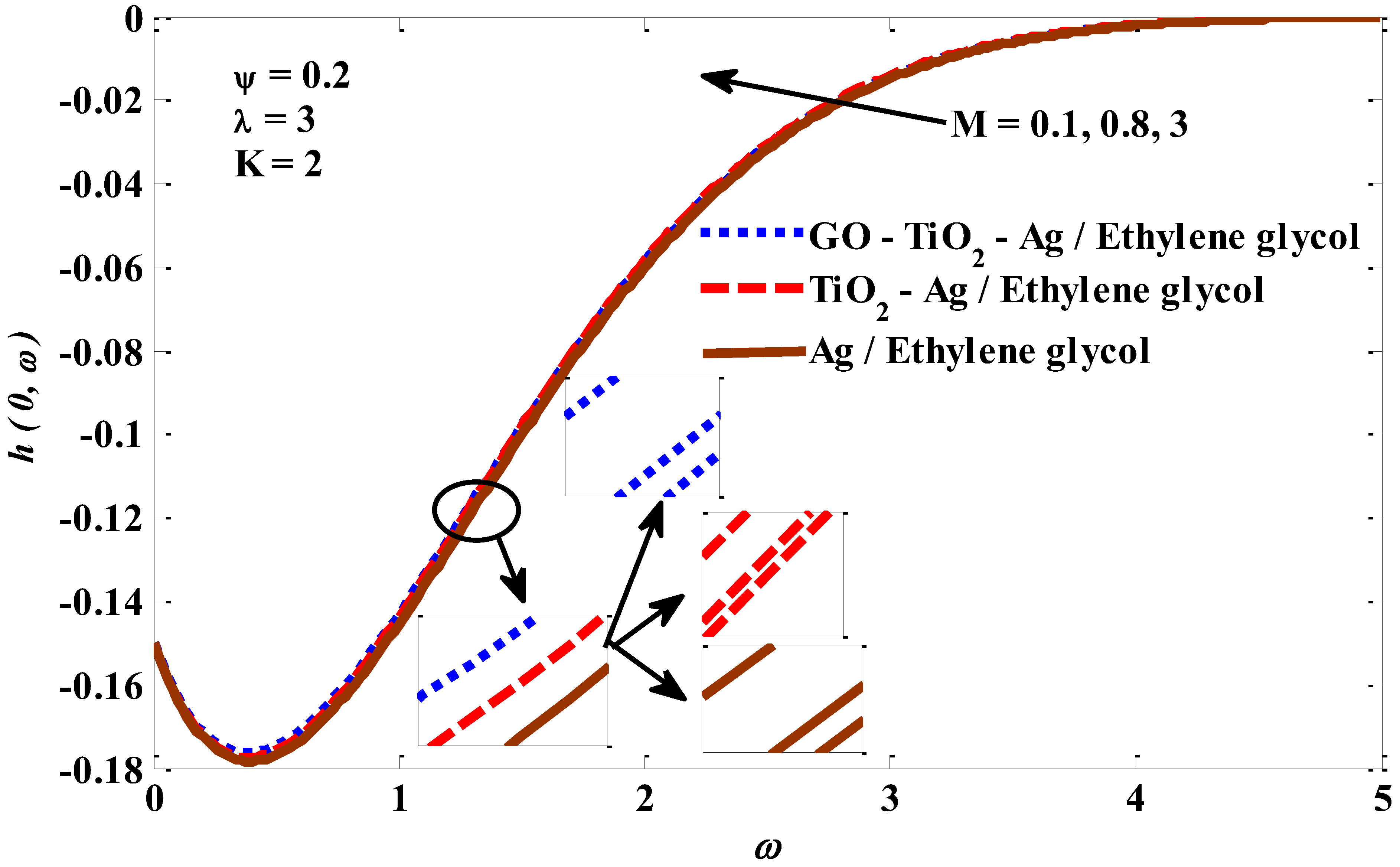
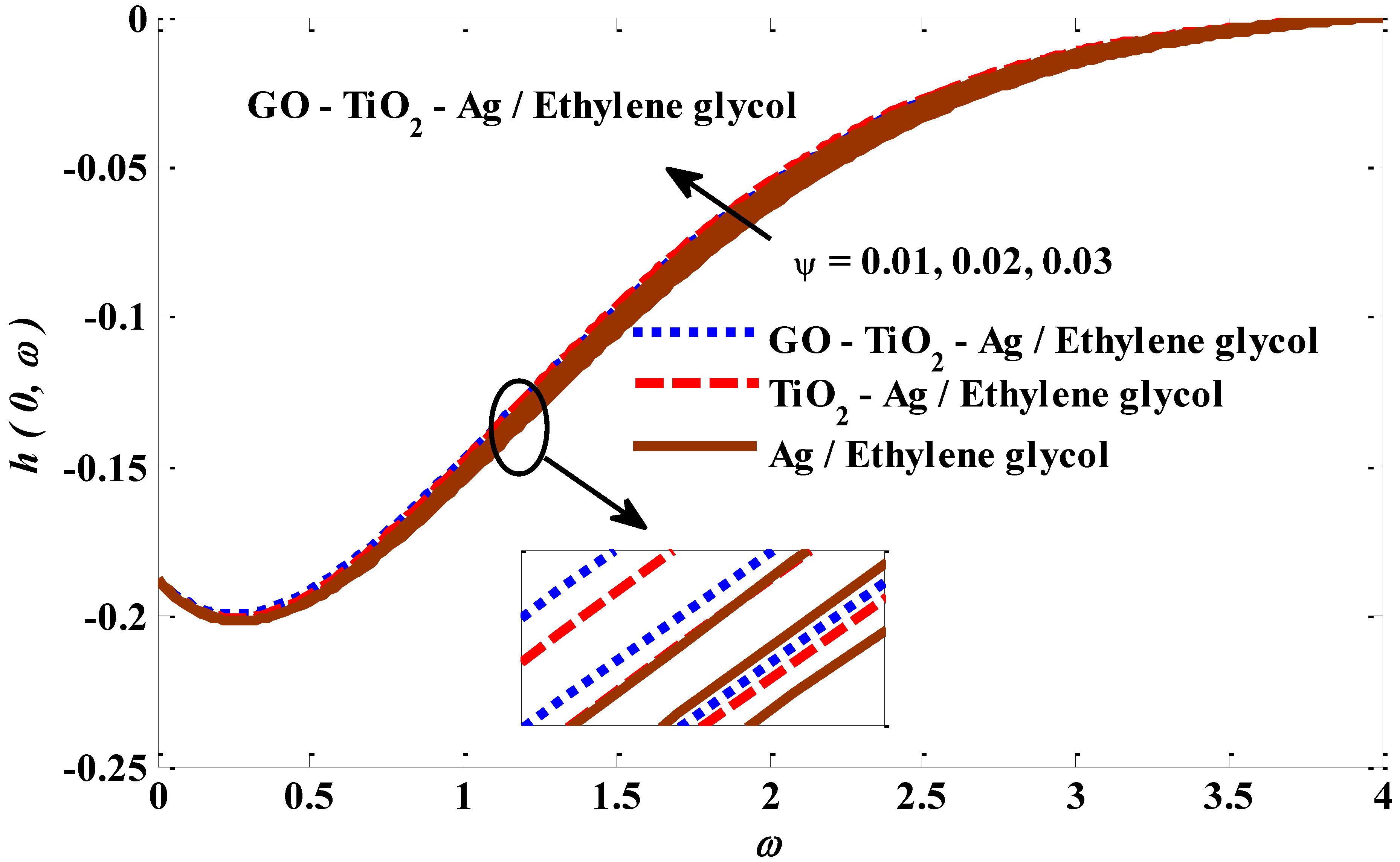
| ζ | |||||||||
|---|---|---|---|---|---|---|---|---|---|
| −0.85 | −0.6 | −0.4 | −0.2 | 0.0 | 0.2 | 0.34 | 0.35 | 5.0 | |
| 0.0 | 0.0000 | 0.0000 | 0.0000 | 0.0000 | 0.0000 | 0.0000 | 0.0000 | 0.0000 | 0.0000 |
| 0.0000 | 0.0000 | 0.0000 | 0.0000 | 0.0000 | 0.0000 | 0.0000 | 0.0000 | 0.0000 | |
| 0.2 | 0.0098 | 0.1003 | 0.1550 | 0.2044 | 0.2445 | 0.2782 | 0.3024 | 0.30227 | 0.7951 |
| 0.0170 | 0.0917 | 0.1547 | 0.2020 | 0.2421 | 0.2778 | 0.3009 | 0.3025 | 0.7947 | |
| 0.4 | 0.1507 | 0.2865 | 0.3849 | 0.4624 | 0.5333 | 0.5788 | 0.5820 | 1.5605 | |
| 0.1456 | 0.2816 | 0.3788 | 0.4600 | 0.5319 | 0.5783 | 0.5815 | 1.5595 | ||
| 0.6 | 0.1174 | 0.3782 | 0.5107 | 0.6342 | 0.7450 | 0.8128 | 0.8207 | 2.2722 | |
| 0.1051 | 0.3550 | 0.5084 | 0.6331 | 0.7422 | 0.8121 | 0.8170 | 2.2683 | ||
| 0.8 | 0.3583 | 0.5753 | 0.7481 | 0.9007 | 0.9938 | 1.0016 | 2.9051 | ||
| 0.3475 | 0.5721 | 0.7447 | 0.8926 | 0.9866 | 0.9931 | 2.8983 | |||
| 1.0 | 0.2119 | 0.5518 | 0.7880 | 0.9803 | 1.1009 | 1.1036 | 3.4406 | ||
| 0.2097 | 0.5537 | 0.7827 | 0.9725 | 1.0912 | 1.0993 | 3.4311 | |||
| 1.2 | 0.4411 | 0.7507 | 1.0021 | 1.1310 | 1.1412 | 3.8587 | |||
| 0.4360 | 0.7410 | 0.9773 | 1.1218 | 1.1316 | 3.8535 | ||||
| 1.4 | 0.1976 | 0.6263 | 0.9104 | 1.1123 | 1.1238 | 4.1582 | |||
| 0.1585 | 0.6175 | 0.9094 | 1.0811 | 1.0927 | 4.1575 | ||||
| 1.6 | 0.4340 | 0.7727 | 1.0171 | 1.0225 | 4.3374 | ||||
| 0.4095 | 0.7774 | 0.9786 | 0.9920 | 4.3397 | |||||
| 1.8 | 0.0510 | 0.6402 | 0.8279 | 0.8555 | 4.1902 | ||||
| 0.0408 | 0.5955 | 0.8296 | 0.8448 | 4.002 | |||||
| 2.0 | 0.4122 | 0.7230 | 0.7581 | 4.3476 | |||||
| 0.3817 | 0.6544 | 0.6713 | 4.3411 | ||||||
| −0.6 | 2.0547 | 2.0567 |
| −0.4 | 1.9046 | 1.9088 |
| −0.2 | 1.8157 | 1.8172 |
| 0.0 | 1.7517 | 1.7555 |
| 0.2 | 1.7018 | 1.7073 |
| 0.4 | 1.6608 | 1.6663 |
| 0.6 | 1.6260 | 1.6269 |
| 0.8 | 1.5958 | 1.5967 |
| 1.0 | 1.5692 | 1.5705 |
| 1.4 | 1.5239 | 1.5247 |
| 1.8 | 1.4863 | 1.4883 |
| 3.0 | 1.4015 | 1.4046 |
| Thermo-Physical Feature | Ethylene Glycol | Ag | GO | Fe3O4 |
|---|---|---|---|---|
| Cp (J/kg K) | 2415 | 235 | 717 | 670 |
| β × 10−5 (K−1) | 57 | 1.89 | 28 | 20.6 |
| ρ (kg/m3) | 1114 | 10500 | 1800 | 5180 |
| K (W/m K) | 0.252 | 429 | 5000 | 80.4 |
| σ (s/m) | 1.07 × 10−6 | 6.3 × 107 | 6.3 × 107 | 1.12 × 105 |
| Pr | 29.8 | - | - | - |
Disclaimer/Publisher’s Note: The statements, opinions and data contained in all publications are solely those of the individual author(s) and contributor(s) and not of MDPI and/or the editor(s). MDPI and/or the editor(s) disclaim responsibility for any injury to people or property resulting from any ideas, methods, instructions or products referred to in the content. |
© 2023 by the authors. Licensee MDPI, Basel, Switzerland. This article is an open access article distributed under the terms and conditions of the Creative Commons Attribution (CC BY) license (https://creativecommons.org/licenses/by/4.0/).
Share and Cite
Alwawi, F.A.; Swalmeh, M.Z.; Hamarsheh, A.S. Computational Simulation and Parametric Analysis of the Effectiveness of Ternary Nano-composites in Improving Magneto-Micropolar Liquid Heat Transport Performance. Symmetry 2023, 15, 429. https://doi.org/10.3390/sym15020429
Alwawi FA, Swalmeh MZ, Hamarsheh AS. Computational Simulation and Parametric Analysis of the Effectiveness of Ternary Nano-composites in Improving Magneto-Micropolar Liquid Heat Transport Performance. Symmetry. 2023; 15(2):429. https://doi.org/10.3390/sym15020429
Chicago/Turabian StyleAlwawi, Firas A., Mohammed Z. Swalmeh, and Abdulkareem Saleh Hamarsheh. 2023. "Computational Simulation and Parametric Analysis of the Effectiveness of Ternary Nano-composites in Improving Magneto-Micropolar Liquid Heat Transport Performance" Symmetry 15, no. 2: 429. https://doi.org/10.3390/sym15020429
APA StyleAlwawi, F. A., Swalmeh, M. Z., & Hamarsheh, A. S. (2023). Computational Simulation and Parametric Analysis of the Effectiveness of Ternary Nano-composites in Improving Magneto-Micropolar Liquid Heat Transport Performance. Symmetry, 15(2), 429. https://doi.org/10.3390/sym15020429









